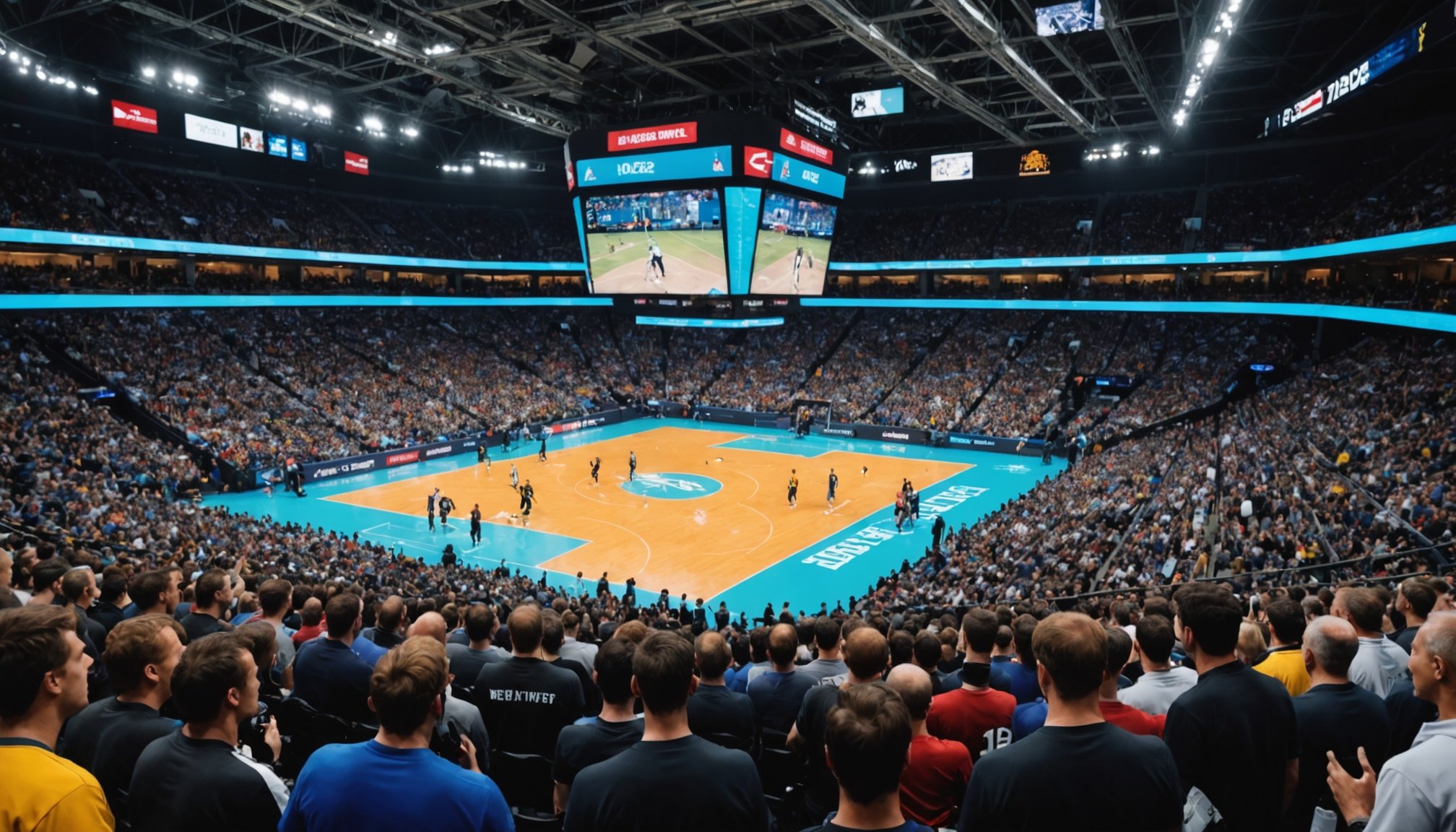Overview of AI in Sports Gaming
Artificial Intelligence (AI) has become a game-changer in the sports gaming industry, offering enhancements in realism and engagement. As AI evolves, it integrates with sports gaming technologies, creating interactive and immersive experiences. Historically, AI’s inclusion in gaming can be traced to simpler forms of decision-making systems which have evolved to include complex technology integration that simulates real-world scenarios.
In recent years, the evolution of crowd simulations has marked a significant milestone. These simulations leverage intricate algorithms to create authentic crowd dynamics that respond to in-game events. By simulating enthusiastic fans in response to a goal or a pivotal match moment, AI breathes life into virtual stadiums. The sophistication of these systems has progressed, transitioning from programmed reactions to dynamic interactions influenced by the game’s context.
In the same genre : Achieving Perfect Character Balance in Fighting Games: Essential Techniques for Game Developers
Modern sports gaming platforms utilise AI to mimic real-time sports dynamics, enhancing user experience. This technology integration ensures that the boundary between reality and the digital realm continues to blur, offering players an increasingly authentic experience. AI’s role in this integration underscores its importance in shaping the future of sports gaming, making it a field teeming with potential and ongoing innovation.
The Technology Behind Realistic Crowd Responses
In the development of authentic crowd simulations in sports gaming, understanding crowd behaviour is crucial. Algorithms, meticulously designed to model crowd dynamics, play a pivotal role. These leverage both machine learning and data analysis, allowing games to accurately reflect crowd reactions. Such reactions can vary from a unified cheer for a successful goal to collective disappointment during a crucial miss.
Additional reading : Mastering AI in Game Development: Innovative Techniques to Create Engaging and Immersive Gaming Experiences
Machine learning enhances this by predicting crowd reactions based on historical data. It adapts these reactions over time, refining the authenticity of the virtual crowd’s behaviour, ensuring it mimics real-world responses. This capability makes games more captivating and responsive to players’ in-game actions.
Data analytics fuels the creation of interactive and true-to-life encounters. By analysing vast datasets about normal audience behaviour, games can simulate realistic responses to various scenarios. This integration of data-driven insights ensures that crowd reactions remain dynamic and relevant.
These advances in technological integration ensure that the boundary between virtual and real fans becomes increasingly indistinct. As AI continues to evolve, crowd simulations in sports gaming will likely see further enhancements, elevating player engagement and overall gaming experiences.
Future Trends in AI and Sports Gaming
As the integration of Artificial Intelligence in sports gaming accelerates, future developments promise profound innovations. Anticipated advancements include heightened technology integration, where AI capabilities enhance not just realism but also strategic elements of gameplay. This evolution could redefine player strategies in ways currently unimaginable.
Future trends suggest a potential shift towards machine learning-driven opponents that can adapt and evolve based on player tactics, providing a more challenging and personalized gaming experience. Additionally, crowd simulations are expected to advance, creating even more responsive and realistic environments influenced by current, real-world sports events.
Market-wise, the continuous integration of AI may lead to a surge in demand for games that offer unique, AI-driven interactions. Developers could prioritize communities’ feedback, using it as a data-driven approach to enhance game lifecycles. This iteration process not only enriches user experience but also supports sustained engagement.
Looking ahead, the landscape of game design will likely embrace AI as a core component, pushing boundaries for immersive experiences and necessitating novel approaches in game development. This continual evolution reaffirms AI’s pivotal role in shaping the future of sports gaming.
Benefits of AI-Driven Crowd Interactions
AI-driven crowd interactions bring a transformative impact on user experience within sports gaming. The enhanced realism contributes significantly to player immersion. With AI simulating dynamic crowd reactions, the virtual atmosphere closely mirrors the energy of real-world stadiums. This not only enriches emotional engagement but allows players to feel as if they are genuinely part of a live event.
The use of AI also elevates the replay value of sports games. As each match can spawn different crowd responses, players experience varied scenarios each time they play. This variability ensures that the gaming experience remains fresh and compelling, encouraging players to return for more engaging gameplay.
Furthermore, realistic crowd simulations directly impact the overall gaming experience, as the illusion of an active, responsive crowd heightens the excitement and drama of in-game events. Players are naturally drawn to more immersive environments, and as AI continues to refine these simulations, the boundary between reality and digital environments will blur even further, solidifying the value of AI in sports gaming.
Through these benefits, AI-driven crowd interactions can revolutionize gaming, offering a level of engagement and immersion previously unattainable.
Case Studies of AI Implementation in Sports Games
Examining case studies of AI implementation reveals the transformative impact of Artificial Intelligence in sports gaming. Consider the popular game “FIFA,” which utilises AI-enhanced crowd simulations that replicate authentic stadium atmospheres. These environments heighten player engagement, as users report feeling more connected to virtual matches, attributing this to the vibrant, dynamic crowds.
Another compelling example is the “NBA 2K” series. Here, AI-driven crowd interactions merge machine learning and data analysis, creating a seamless blend of realism. Players frequently commend the adaptive nature of the game’s AI, which reflects live crowd feedback based on match developments. This responsive environment is a marked departure from traditional, static crowd simulations, enriching the overall user experience.
Comparing these advancements to conventional designs highlights a clear evolution. Traditionally, crowd simulations offered predictable, repetitive patterns, lacking depth. AI enhancement introduces variability, creating varied emotional engagement pathways for players. Users note this innovation augments the game’s replay value, encouraging repeated gameplay.
Such AI implementation showcases the critical role of modern technology in revolutionising game design, offering insights into the future potential of sports gaming platforms. Players and developers alike anticipate these technologies continuing to push boundaries in interactivity and realism.
Challenges and Limitations of AI in Sports Gaming
Implementing AI-driven crowd interactions in sports gaming poses significant challenges. One primary limitation involves the computational demands required to simulate complex crowd behaviours in real-time. This can lead to performance issues, such as reduced frame rates or lag, hindering user experience.
Another challenge is the precise modelling of crowd dynamics to reflect realistic human emotions and reactions. While AI and machine learning can simulate a range of responses, capturing authenticity requires vast, detailed datasets to train algorithms effectively. Technical issues and data limitations can result in less convincing simulations, impacting the immersive quality that players seek.
There’s also the matter of ethical considerations in using AI to mimic human behaviour. AI systems could unintentionally incorporate biases present in training data, leading to representations that do not accurately reflect diverse populations. Addressing these ethical concerns is vital to ensure fair and accurate depictions within games.
Furthermore, developers must navigate the limitations of current AI technology, seeking innovative solutions to enhance realism while optimising performance. Balancing advanced AI integration with hardware capabilities remains a complex task, requiring ongoing research and adaptation in both programming and design approaches.
Future Trends in AI and Sports Gaming
As advancements in Artificial Intelligence rapidly continue, the future of sports gaming promises intriguing yet profound transformations. Emerging trends showcase a shift towards machine learning-driven opponents, which can dynamically morph and adapt according to individual player strategies. This not only enriches gameplay but also ensures a more personalised experience.
In addition, developments in crowd simulations are anticipated to reach new heights. These improvements will create hyper-responsive environments that mirror live sports events more intricately than ever before. Coupled with technological strides in data analytics, these advancements promise to craft real-time, dynamic interactions that engage players on deeper levels.
The market for sports gaming is predicted to expand significantly as AI integration fuels demand for highly interactive experiences. A potential shift could see developers leveraging community feedback to inform game adjustments, ensuring that AI-enhanced interactions remain relevant and engaging. This iterative approach bolsters sustained player engagement.
Looking forward, AI will surely become a foundation within game design, prompting innovative design methodologies. This evolution not only pushes experiential boundaries but also elevates sports gaming to new realms of interactivity and realism, redefining how players interact with virtual worlds.











